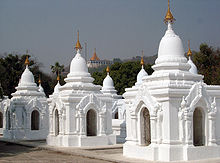Tripiṭaka tablets at Kuthodaw Pagoda

Stone tablets inscribed with the Tripiṭaka (and other Buddhist texts) stand upright in the grounds of the Kuthodaw Pagoda (kuthodaw means 'royal merit') at the foot of Mandalay Hill in Mandalay, Myanmar (Burma). The work was commissioned by King Mindon as part of his transformation of Mandalay into a royal capital. It was completed in 1868. The text contains the Buddhist canon in the Burmese language.
There are 730 tablets and 1,460 pages. Each page is 1.07 metres (3+1⁄2 ft) wide, 1.53 metres (5 ft) tall and 13 centimetres (5+1⁄8 in) thick. Each stone tablet has its own roof and precious gem on top in a small cave-like structure of Sinhalese relic casket type called kyauksa gu (stone inscription cave in Burmese), and they are arranged around a central golden pagoda.[1]
UNESCO inscription

In 2013,
Royal merit


The pagoda itself was built as part of the traditional foundations of the new royal city which also included a pitakat taik or library for religious scriptures, but
The marble was quarried from
Assembly and contents
The stones are arranged in neat rows within three enclosures, 42 in the innermost, 168 in the middle and 519 in the outermost enclosure. The caves are numbered starting from the west going clockwise (let ya yit) forming complete rings as follows:[1]

| Enclosure | Cave number | Pitaka |
|---|---|---|
| inner | 1–42 | Vinaya Pitaka
|
| middle near | 43–110 | Vinaya |
| middle far | 111–210 | 111 Vinaya, Abhidhamma Pitaka 112–210
|
| outer nearest | 211–319 | Abhidhamma |
| outermost perimeter | 320–465 | Abhidhamma 310–319, Samyutta Nikaya 418–465
|
| outermost next in | 466–603 | Samyutta 466–482, Khuddaka Nikaya 561–603
|
| outermost near | 604–729 | Khuddaka |
Thirty years later in 1900, a print copy of the text came out in a set of 38 volumes in Royal
Annexation, desecration and restoration

The British later invaded the North, the gems and other valuables were looted, and the buildings and images vandalised by the troops billeted in the temples and pagodas near the walled city and Mandalay Hill. When the troops withdrew from religious sites after a successful petition to
The gold writing had disappeared from all 729 marble tablets, along with the bells from the hti (umbrella or crown) of each of the small stupas, and they were now marked in black ink, made from shellac, soot from paraffin lamps and straw ash, rather than in gold, and few of the gems still exist. Mobyè Sitkè also asked permission from senior monks to plant star flower trees (Mimusops elengi) between the rows of kyauksa gus.[1] The inscriptions have been re-inked several times since King Thibaw had it done for the second time in gold. The undergrowth amongst the caves was cleared and paved through public donations appealed for in the Ludu Daily in 1968.[1] The words of the Buddha are still preserved there, therefore making it a popular destination for devout Buddhists as well as scholars and tourists.
